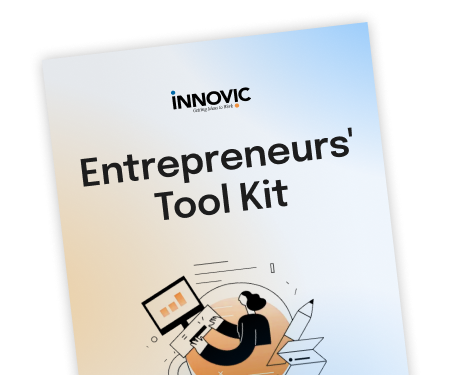Resources
It’s hard to know where to begin with a new idea, product or service. We’ve put together a useful compilation of guides, resources and tips that will help take the guesswork out of turning your idea into a commercially viable product or business.

Resources
It’s hard to know where to begin with a new idea, product or service. We’ve put together a useful compilation of guides, resources and tips that will help take the guesswork out of turning your idea into a commercially viable product or business.

INNOVIC Forms
When discussing a new, unprotected idea with a third party it is advisable to use a Non Disclosure Agreement (NDA) – also referred to as a Confidentiality Agreement. A free copy of INNOVIC’s NDA can be downloaded here.
To develop your idea into a successful business and attract investors you would normally need a business plan. A business plan will help you to identify and map each element of your future business. It will also help you to plan how you will achieve your aims and objectives and enable you to identify the skills, resources, and finance you will need.
INNOVIC Resources
- patents for new or improved products or processes;
- trademarks for words, symbols, pictures, sounds, smells or a combination of these, to distinguish the goods and services of one trader from those of another;
- designs for the shape or appearance of manufactured goods;
- copyright for original material in literary, artistic, dramatic or musical works, films, broadcasts, multimedia and computer programs;
- circuit layout rights for the 3-dimensional configuration of electronic circuits in integrated circuit products or layout designs;
- plant breeder’s rights for new plant varieties; and
- confidentiality/trade secrets including know-how and other confidential or proprietary information.
This toolkit covers everything you need to know about starting an innovative business; including the legal requirements, government programs and grants, protecting your digital ideas, how to grow your business and what to do if a dispute arises.
This information regarding licensing was kindly provided by Rodney De Boos (Partner) and Sally Wilson (Lawyer) of Davis Collison Cave Solicitors.
What is licensing?
Licensing is concerned with granting rights to use commercially valuable intellectual property. The process is sometimes referred to as “technology transfer” but strictly speaking this is too narrow term. The subject matter of a licence can include the full range of intellectual property rights, including patent rights, designs, copyright, trade marks, circuit layouts, plant breeders rights and know-how. Confidential information will also typically play a critical role in the “technology transfer”.
Licensing itself is the process where the owner of one or more of these rights gives another person permission to exploit the subject matter of the rights. In other words, the person granting the licence (the “licensor”) is giving to the person receiving the licence (the “licensee”) a level of authority to carry out activities which would otherwise be an infringement of the licensor’s rights.
Franchising is not a business itself, but a way of doing business. It is essentially a marketing concept – an innovative method of distributing goods and services. It is also an extremely successful and rapidly growing aspect of Australia’s small business sector.
Franchising is a business relationship in which the franchisor (the owner of the business providing the product or service) assigns to independent people (the franchisees) the right to market and distribute the franchisor’s goods or service, and to use the business name for a fixed period of time. The International Franchise Association defines franchising as a continuing relationship in which the franchisor provides a licensed privilege to do business, plus assistance in organising training, merchandising and management in return for a consideration from the franchisee.
Questions to ask when choosing a patent attorney. Answers to the following questions should assist you in determining whether the attorney or firm you are approaching will be the right choice.
Who will do my work?
It is important that you understand who will be doing your work and whether the patent attorney you have chosen will be assisted by someone else.
Are they registered as a patent attorney in Australia and when were they registered?
Registration of patent attorneys is administered by the Federal Government through the Professional Standards Board for Patent and Trade Marks Attorneys (the Board). Australian patent attorneys must meet a set of stringent criteria administered by the Board. Registration of Australian patent attorneys can be checked by reviewing the Registration of Australian patent attorneys website.
Whether you’re looking for grants or investors, obtaining finance can be very difficult. You typically need a strong business plan as a minimum to commence the capital raising process. Investors or funding bodies will need to know in detail what you intend to use the money for. Visit the INNOVIC website to download our Business Plan template.
For more information you can also refer to the book Business Plans for Dummies for a well written and easy to understand guide.
How do you pitch your idea to potential investors?
David Bennett of Powerflex Corporation co-presented at INNOVIC’S Grants and Finance seminar and outlined 10 Things Investors Care About.
Trying to get some PR? Looking for tips on talking to the media? Read this document for information.
- Only do an interview if it will help one of your objectives.
- Be clear which people you are talking to – they must be critical to your objective.
- Have one message, and back it up with one or more reasons and examples.
- If it’s for a direct quote –
- Make sure your message is catchy and about 20 words long.
- Insert the key phrase of your catchy message into several answers.
- Pause before answering if you want time to think.
- Stop in mid-sentence if you’re not happy with what you’re saying.
- If it’s a question-answer interview where the questions stay in –
- Acknowledge all questions.
- Say anything you want that’s relevant after the acknowledgment.
- Cut across interruptions with ‘just a moment’ and go on.
- For strong answers use the sequence: main point, reason, example.
- If reporters want information only, put that on paper and give it to them, or send by fax or email, rather than saying it in an interview.
With the compliments of Roger Fry & Company – leading media trainers in Australia for 30 years. This material may be used free of charge. For more information and newsletters visit the website.
Phone: 03 9419 4188
Fax: 03 9419 7139
Email: admin@rogerfry.com.au
Website: www.rogerfry.com.au
Marketing is a necessary stage in any commercialisation process. A Marketing Plan can:
- Help identify sources of competitive advantage
- Encourage an organised and systematic approach
- Communicate a clear and consistent message, which is often very difficult for a new product or service.
- Sets objectives and plans
This flow chart illustrates various phases in the commercialisation process, detailing the stage, what needs to be done and who can help.
When assessing an app developer’s capabilities, it’s important to ask questions that evaluate their technical skills, communication abilities, and approach to app development. Below is a list of key questions to ask.

- Idea Evaluation
- Business Structures
- Funding and Key Grants
Get your FREE Entrepreneurs' Tool Kit
Get your FREE
Entrepreneurs' Tool Kit

- Idea evaluation
- Business structures
- Funding and key grants
Get your FREE Entrepreneurs' Tool Kit
- Idea evaluation
- Business structures
- Funding and key grants



